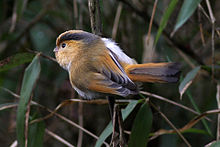Suthora
| Suthora | |
|---|---|
 | |
| Fulvous parrotbill (Suthora fulvifrons) | |
| Scientific classification | |
| Domain: | Eukaryota |
| Kingdom: | Animalia |
| Phylum: | Chordata |
| Class: | Aves |
| Order: | Passeriformes |
| Family: | Paradoxornithidae |
| Genus: | Suthora Hodgson, 1837 |
| Type species | |
| Suthora nipalensis Hodgson, 1837 | |
Suthora is a genus of parrotbills in the family Paradoxornithidae.
Taxonomy
[edit]The genus Suthora was introduced in 1837 by the English naturalist Brian Houghton Hodgson with the type species as Suthora nipalensis, the black-throated parrotbill.[1][2] The genus name is the Nepalese word for the black-throated parrotbill (Suthora nipalensis).[3] The genus now includes species formerly placed in the genera Neosuthora, Chleuasicus, and Sinosuthora. These genera are now considered as junior synonyms of Suthora based on the results of a molecular phylogenetic study by Tianlong Cai and collaborators published in 2019.[4][5]
Species
[edit]The genus contains the following 12 species:[5]
| Image | Common Name | Scientific name | Distribution |
|---|---|---|---|
| Short-tailed parrotbill | Suthora davidiana | China, Laos, Myanmar, Thailand, and Vietnam | |
 | Fulvous parrotbill | Suthora fulvifrons | Nepal, Bhutan, China |
 | Black-throated parrotbill | Suthora nipalensis | Bhutan, India, Laos, Myanmar, Nepal, Thailand, Tibet and Vietnam. |
 | Golden parrotbill | Suthora verreauxi | China, Laos, Myanmar, Taiwan, and Vietnam. |
 | Pale-billed parrotbill | Suthora atrosuperciliaris | Bangladesh, Bhutan, China, India, Laos, Myanmar, and Thailand |
| Spectacled parrotbill | Suthora conspicillata | central China | |
| Grey-hooded parrotbill | Suthora zappeyi | central China | |
 | Brown-winged parrotbill | Suthora brunnea | Myanmar to sc and sw China |
| Eye-ringed parrotbill | Suthora ricketti | south Sichuan and north Yunnan (China). | |
 | Vinous-throated parrotbill | Suthora webbiana | China, Japan, Korea, Mongolia, Russia, Taiwan, and Vietnam |
 | Ashy-throated parrotbill | Suthora alphonsiana | China, Vietnam |
 | Przevalski's parrotbill | Suthora przewalskii | central China |
References
[edit]- ^ Hodgson, Brian Houghton (1837). "Indications of some new forms belonging to the Parianae". India Review and Journal of Foreign Science and the Arts. 2 (1): 30–34 [32].
- ^ Mayr, Ernst; Paynter, Raymond A. Jr, eds. (1964). Check-List of Birds of the World. Vol. 10. Cambridge, Massachusetts: Museum of Comparative Zoology. p. 431.
- ^ Jobling, James A. "Suthora". The Key to Scientific Names. Cornell Lab of Ornithology. Retrieved 31 January 2024.
- ^ Cai, T.; Cibois, A.; Alström, P.; Moyle, R.G.; Kennedy, J.D.; Shao, S.; Zhang, R.; Irestedt, M.; Ericson, P.G.P.; Gelang, M.; Qu, Y.; Lei, F.; Fjeldså, J. (2019). "Near-complete phylogeny and taxonomic revision of the world's babblers (Aves: Passeriformes)". Molecular Phylogenetics and Evolution. 130: 346–356. doi:10.1016/j.ympev.2018.10.010. PMID 30321696.
- ^ a b Gill, Frank; Donsker, David; Rasmussen, Pamela, eds. (December 2023). "Sylviid babblers, parrotbills, white-eyes". IOC World Bird List Version 14.1. International Ornithologists' Union. Retrieved 31 January 2024.


 French
French Deutsch
Deutsch